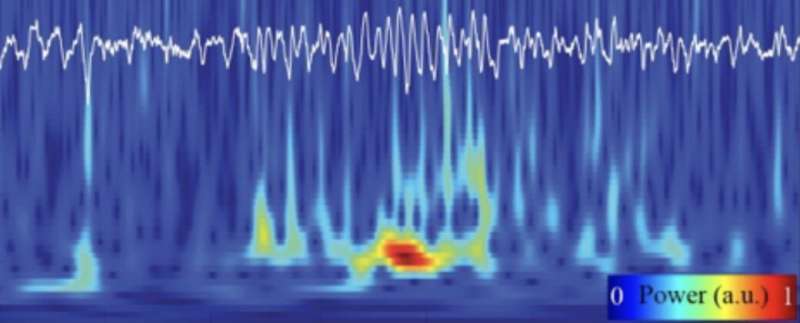Recordings revealed that the coordination of electricophysiological oscillations between two brain regions (hippocampus and parietal cortex) plays a key role in solidifying long-term memories and differs from the oscillations primarily involved in creating initial memories. The image shows a sample recording. Credit: Columbia University
Neuroscientists know that what makes a memory really stick is reconsolidation, when a new memory is reactivated by identical or similar experiences, stimulating the creation of additional and stronger neural connections.
If researchers can better understand what happens in the brain during reconsolidation, new ways to strengthen memories weakened by dementia or to suppress unwanted memories in post-traumatic stress disorder potentially could be created.
Oscillations in the brain's electrical activity—aka brain waves—are already known to play a role in the creation of new memories. So a team of Columbia neuroscientists led by Jennifer Gelinas, MD, Ph.D., assistant professor of neurology at Columbia University Vagelos College of Physicians and Surgeons, set out to determine how brain oscillations interact to help memories strengthen.
To accomplish this, the neuroscientists recorded the brain oscillations of rats as they navigated a maze, finding water rewards they remembered and encountering new ones. The findings are published in the journal Proceedings of the National Academy of Sciences.
The recordings revealed that the coordination of brain oscillations between two brain regions (hippocampus and parietal cortex) plays a key role in solidifying long-term memories and differs from the brain oscillations primarily involved in creating initial memories.
Sample rat performing CB and OA tasks. CB: 2 sample trials with different reward locations. OA: 2 sample trials with same rewarded object in different spatial locations. Video played at 2 × speed. Credit: Proceedings of the National Academy of Sciences (2023). DOI: 10.1073/pnas.2207909120
To make a memory stick, coordinated interaction between high frequency ripples in the brain's hippocampus and high frequency ripples in the parietal cortex was required, whereas memory creation required high frequency ripples in the hippocampus and lower frequency oscillations in the cortex.
Simply by looking at the brain recordings, the investigators could determine if rats were learning a new memory or strengthening an older one.
The findings suggests that different mechanisms are at play when memories are consolidated and reconsolidated, which has potential clinical implications.
"Many neurologic conditions are characterized by either underactive or overactive retention of long-term memories," says Gelinas. "It's possible that some of these oscillations we've identified are deranged in these conditions. A better understanding of these processes could lead to new ways of diagnosing and treating these memory issues."
The team is now applying these findings to models of neuropsychiatric disease with the goal of identifying new opportunities for improving memory function.
More information: Prawesh Dahal et al, Hippocampal–cortical coupling differentiates long-term memory processes, Proceedings of the National Academy of Sciences (2023). DOI: 10.1073/pnas.2207909120
Journal information: Proceedings of the National Academy of Sciences
Provided by Columbia University
























